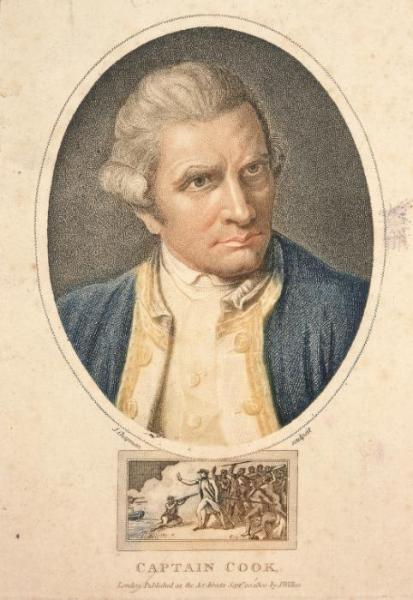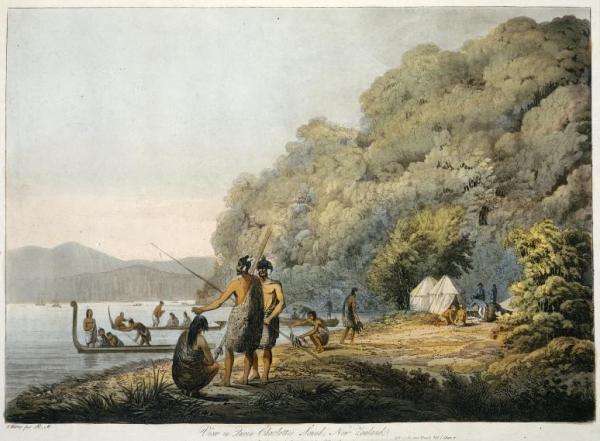Meretoto - Captain Cook's Ship Cove
Captain James Cook spent a total of 328 days exploring the New Zealand coastline during his three voyages, returning to Ship Cove on five separate occasions
Captain James Cook spent a total of 328 days exploring the New Zealand coastline during his three voyages. The initial purpose of Cook's voyages was to observe the Transit of Venus in Tahiti and then search for a great southern continent which was believed to exist - Terra Australis. Cook was to return to Meretoto, which he named Ship Cove, in Tōtaranui/Queen Charlotte Sound, on five separate occasions. He spent over 100 days there, as it provided safe anchorage, food and fresh water and timber for repairs to his ship.1
Cook's First Voyage involved a six month long circumnavigation of Aotearoa/New Zealand. His ship, the Endeavour, sailed into Ship Cove on 16 January, 1770. He described it as a "very snug cove" and recorded that: "The number of Inhabitants hardly exceeds 3 or 400 people, they leive (sic) dispers'd along the Shores in search of their daly (sic) bread, which is fish and firn (sic) roots for they cultivate no part of the lands" (Journals of Captain Cook, 6 February, 1770).2
Cook's Second Voyage involved two ships, the Resolution, commanded by Cook, and the Adventure commanded by Lieutenant Tobias Furneaux. They left from Plymouth in England on 13 July 1772 and met at Meretoto/Ship Cove in May 1773 but lost contact with each other after they left Tōtaranui/Queen Charlotte Sound and later both visited the Marlborough Sounds area separately.3
Cook later learned that ten men from the Adventure had been attacked and killed at Wharehunga Bay, Arapawa Island. While it was expected that Cook would seek revenge for the killings on his return (third) voyage, he did not, and acted with commonsense and restraint.
Attempts were made by the Europeans to introduce various animals. Furneaux liberated a boar, and a sow and a pair of goats were released on Arapawa Island. Rats, chickens and more pigs were also introduced to New Zealand by Cook's ships. Cook put a ewe and a ram ashore at Meretoto/Ship Cove and was disappointed with his failure to introduce sheep: "Last Night the Ewe and Ram I had with so much care and trouble brought to this place, died, we did suppose that they were poisoned by eating of some poisonous plant, thus all my fine hopes of stocking this Country with a breed of Sheep were blasted in a moment" (Journals of Captain Cook, 23 May 1773).4
The Europeans left potatoes, and turnips as well as other vegetables. They also brought serious diseases to Māori, including tuberculosis, and venereal diseases.
During this Second Voyage, Cook recorded that some Māori families were living near their ships and supplying them with fish. He acknowledged that their fishing methods and expertise were superior to those of his own countrymen. Cook left the Marlborough Sounds on 7 June 1773, but he returned to Meretoto/ Ship Cove again in November, leaving on 25th November, to return in October 1774, still on his Second Voyage.5
Cook's Third Voyage commanding the Resolution and accompanied by the Discovery, included a stay at Meretoto/Ship Cove "in our old station" in February 1777 to refresh and refit the ships. Captain Cook was 47 years old and clearly weary with the demanding and dangerous voyages and dealing with the various peoples of the Pacific. He began to behave less tolerantly and on 14th February 1779, over-reacted to a theft in Hawaii, which resulted in a fight in which Cook was killed.6
During his three voyages to New Zealand, James Cook mapped the outline of the country with considerable accuracy. His observations of Māori culture, and natural history, combined with the observations recorded by his men provide a rich source of information and his comments on the abundance of whales, seals, timber, and flax encouraged British interest.

This story is an edited version of an article written by Steve Austin, Chief Executive of the Marlborough Museum and published in Wild Tomato, 2008, and includes additional material from The Captain Cook Encyclopedia. Updated December 2020
Story by: Joy Stephens (editor)
Sources
- Robson, J. (2004). The Captain Cook Encyclopedia. London : Chatham Pub, p186
Beaglehole, J. (Ed.) (1955) The voyage of the Endeavour, 1768-1771. Journals of Captain Cook, Vol. 1. Cambridge, U.K.: Cambridge University Press, p. 247 - Robson, p. 186 Beaglehole, J. (Ed). (1961) The voyage of the Resolution and Adventure, 1772-1775. Journals of Captain Cook, Vol.2. Cambridge, U.K.: Cambridge University Press, p.167
- Porter, F. (1978) A sense of history: a commemorative publication for John Cawte Beaglehole, O.M., about James Cook's landing sites in New Zealand. Wellington : E. C. Keating, Govt. Printer, pp.88-9
- Robson, p. 186
Further Sources
Books
- Beaglehole, J. (Ed.) (1955) The voyage of the Endeavour, 1768-1771. Journals of Captain Cook, Vol. 1. Cambridge, U.K.: Cambridge University Press, p. 247
http://www.worldcat.org/oclc/7386635 - Beaglehole, J. (Ed). (1961) The voyage of the Resolution and Adventure, 1772-1775. Journals of Captain Cook, Vol.2. Cambridge, U.K.: Cambridge University Press, p.167
http://www.worldcat.org/oclc/63195 - Beaglehole, J. (1974) The life of Captain James Cook London : A. and C. Black
http://www.worldcat.org/oclc/3121392 - Begg, A. C. (1969) James Cook and New Zealand. Wellington, N.Z.: A.R. Shearer, Govt. Printer
http://www.worldcat.org/oclc/63195 - Conner, D. (1979) Master mariner: Captain James Cook and the peoples of the Pacific. St. Lucia, Queensland [Australia] : University of Queensland Press
http://www.worldcat.org/oclc/4445345 - Darkin, J. (2007) On Cook's Trail : a holiday history of Captain Cook in New Zealand. Auckland , N.Z.: Reed Books.
http://www.worldcat.org/oclc/166312235 - Hough, R. (1994) Captain James Cook. London : Hodder & Stoughton
http://www.worldcat.org/oclc/31206583 - Porter, F. (1978) A sense of history: a commemorative publication for John Cawte Beaglehole, O.M., about James Cook's landing sites in New Zealand . Wellington : E. C. Keating, Govt. Printer
http://www.worldcat.org/oclc/5312146 - Robson, J. (2000) Captain Cooks world. Auckland, N.Z.: Random House
http://www.worldcat.org/oclc/45013739 - Robson, J. (2004). The Captain Cook Encyclopedia. London : Chatham Pub, p186
http://www.worldcat.org/oclc/56646306&tab=holdings - Salmond, A. (2003) The trial of the cannibal dog: Captain Cook in the South Seas. London : Allen Lane
http://www.worldcat.org/oclc/51870741 - Salmond, A.(1991) Two worlds: first meetings between Maori and Europeans, 1642-1772. Auckland ; London : Viking
http://www.worldcat.org/oclc/25048911 - Villiers, A. (1967; 2001) Captain Cook, the seamen's seaman. London, Hodder & Stoughton
http://www.worldcat.org/oclc/2630995 - Zimmermann, H. (1926) Zimmermann's account of the third voyage of Captain Cook. 1776-1780. Wellington [N.Z.] Alexander Turnbull Library
http://www.worldcat.org/oclc/154287832
Newspapers
- Bagley, S. (1985) Captain James Cook's D'Urville Island anchorage. Journal of the Nelson and Marlborough Historical Societies, 1(5), p.34-8
http://www.nzetc.org/tm/scholarly/tei-NHSJ04_05-t1-body1-d7.html - Begg, N (1985) Captain Cook at D'Urville. Historic Places in New Zealand, 9, 30
- Davies, J.(1987) Cook : The "Adventure" and misadventure in Queen Charlotte Sound, 1773-1777. Journal of the Nelson and Marlborough Historical Society, 2(1), p.18-23
http://www.nzetc.org/tm/scholarly/tei-NHSJ05_01-t1-body1-d2.html - Davies, J. (1995) Ship Cove - where history echoes still. Marlborough's Past & Present, 1, p.14-15
- Glover, D (1957) Cook's Journals. Landfall, 41, 60-67
- King-Turner, E. (1970) The green island, Journal of the Nelson Historical Society, 2(4), 10-21
http://www.nzetc.org/tm/scholarly/tei-NHSJ02_04-t1-body1-d3.html - Maori occupation (1976) Journal of the Nelson Historical Society, 3(2), pp1-21
http://www.nzetc.org/tm/scholarly/tei-NHSJ03_02-t1-body-d1.html - Miller, D (1955) Early voyages to New Zealand : episodes associated with Captain Cook, Journal of the Nelson Historical Society, 1(1), 2-5
http://www.nzetc.org/tm/scholarly/tei-NHSJ01_01-t1-body-d1.html - Newport, J., Dickinson, B & Cole, G. (1971) Nelson lighthouses, Journal of the Nelson Historical Society, 2(5), pp4-13 [briefly describes coastal features named by Cook)
http://www.nzetc.org/tm/scholarly/tei-NHSJ02_05-t1-body1-d2.html - Ship Cove upgrade (2006, November 22) The Marlborough Express . pp. 17,18
Websites
- The Captain Cook Society - http://www.captaincooksociety.com/ (includes information on Cook's life and voyages, including a New Zealand chronology )
- Cook's voyages (2007). In McLintock, A.H. (Ed.)(1966) History - discovery and exploration, from An Encyclopaedia of New Zealand. Retrieved from
Te Ara - The Encyclopedia of New Zealand:
http://www.teara.govt.nz/en/1966/history-discovery-and-exploration/3 - Duncan, R. (1902) Following the Tracks of Captain Cook.Transactions and Proceedings of the Royal Society of New Zealand 1868-1961, 35, p.33:
http://rsnz.natlib.govt.nz/volume/rsnz_35/rsnz_35_00_000630.html - Early explorers (2008). Retrieved from New Zealand history Online :
http://www.nzhistory.net.nz/culture/explorers - Mackay, David. 'Cook, James 1728 - 1779'. Dictionary of New Zealand Biography, updated 22 June 2007
https://teara.govt.nz/en/biographies/1c25/cook-james - Meretoto/Ship Cove. Hertiage New Zealand listing:
https://www.heritage.org.nz/the-list/details/9900 - South Seas: voyaging and cross-cultural encounters in the Pacific (1760-1800) [documentation about Cook's first voyage]:
https://eresources.sl.nsw.gov.au/south-seas-voyaging-and-cross-cultural-encounters-pacific-1760-1800 - Tipene, A. & Forde,Xavier (2018, June 15) Meretoto and Motuara, Tōtaranui (List no. 9780) New Zealand Heritage list. Retrieved from Rangitane.org.nz:
https://www.rangitane.org.nz/wp-content/uploads/2018/07/Extract-Meretoto-16June18-Notif-II.pdf - Totaranui 250: A community commemoration of the first encounters between Māori and Europeans and the common threads between them (Marlborough Commemoration Oct-Dec 2019)
https://www.totaranui250.co.nz/ - Tuia 250 - History relating to Cook's place names. New Zealand Geographic Board on Google Earth. Retrieved September 2021
Maps
At Picton Museum
- Chronology of Cook's time at Ship Cove, Queen Charlotte Sound (unpublished)
- Print of Queen Charlotte from an original painting by Sir Thomas Lawrence (on display)(Cook named Queen Charlotte Sound after her - wife if King George III)
- Print of Captain James Cook (on display) - an old print from an engraving of Cook

